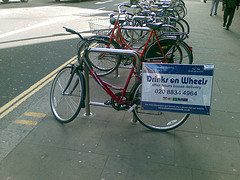The 3 P’s of mobile (and social) advertising from Jonathan MacDonald
 At the MMA Mobile Marketing Forum in Budapest, one of the most dynamic and challenging presentations was from fellow mobile advertising evangelist Jonathan MacDonald, who is a Senior Consultant at Ogilvy.
At the MMA Mobile Marketing Forum in Budapest, one of the most dynamic and challenging presentations was from fellow mobile advertising evangelist Jonathan MacDonald, who is a Senior Consultant at Ogilvy.
Jonathan explained that Ogilvy puts digital, including mobile in the middle of the equation and this is quite unique for an agency with expertise across traditional media.
Ogilvy are incredibly optimistic about the mobile opportunity – they have digital throughout the network and in their DNA. Jonathan thought that while ‘mobile’ will not happen overnight, Ogilvy are working with all parts of the value chain to ensure the ‘year of mobile’ happens as soon as possible!
Jonathan mentioned his 3 P’s of mobile advertising:
- Permission – people will decide what they see/receive/engage with
- Privacy – people will decide where their data is and how it is used
- Preference – people will decide what content they find relevant. Inference and assumption has limited lifespan.
He feels that the biggest opportunity for mobile is as a direct marketing channel due to it being the ultimate engagement media.
Importantly also he mentioned 4 rules of engagement critical to mobile marketing, advertising and communication in general:
1. Transparency of offering
– You need to have plain and simple statements so the person on the receiving end understands what they are getting. The future of small print is big print.
2. Relevancy of communication
Do you want a Ray Taylor concert ticket? Probably not but there may be someone who does. You can’t always give the same incentive to the same person and expect that they will receive in the same way. The value of the incentive needs to be individualized.
3. Ease of interaction
Make it easy – don’t make the person jump through hoops to get the advertising content onto their phone.
4. Relevancy of communication
It is not our brand anymore – it is the people’s brand and network – we must realise that the people have ultimate control of their advertising channel and the content therein.
Jonathan is working on the concept of “The Communication Ideal” – something we all want to attain where the efficiency of marketing is directly proportional to the level of permission. You can join the conversation at http://lc.tl/ci This is something I am going to get involved in because we must as an industry strive to work together to create this new opportunity for advertisers.
Importantly, the communication ideal is not only about permission but also the paradigm of increased knowledge meaning increased relevance.
Jonathan said “change the world or go home” – we need to do something radical or we’ll all be doing the same thing in 2 years so please disrupt now and not in 2 years….
He states: “It is easier to make a change when you can rather than when you must”
A question was raised after his presentation regarding FMCG.
Jonathan’s response was “Do you want the whole relationship with your customers to be in the store only?”
Another question posed was “when do people think about buying our stuff?”
His response was that we don’t know and we can’t predict when this point of inspiration will happen – they need a touch point they carry with them every day and all day and that touch point has become the mobile.
Now I propose we go further and would like to suggest a 4th P of mobile advertising
- Purpose – people will decide if the message has a purpose in their lives
If we have a relationship with a person, what is the purpose of our communication with them? Is it to just use their preferences and permission to increase our brand value in their eyes, or is it to provide them with something that enhances our mutual relationship?
So what is mobile advertising?
Here are two possible candidates.


Of course I am joking – but what, and who defines “mobile” advertising?
I would argue that much of the “mobile advertising” we see today is just “pay and spray”. None of the 3 (or 4) P’s mentioned above are met in most of the executions I have seen today. In fact every mobile advertising campaign I see from now on I will be doing a mental check against the P’s above to see if they are being met.
Mobile advertising is NOT internet advertising, but you would think it is the same because in the industry we talk about banners, impressions, CPC, CPM …. to a person and an advertiser these are meaningless. We’re just stuck it the status quo of the internet space – but let’s innovate and really use the power of the mobile medium with trusted relationships.
As Peggy Salz from Msearchgroove explains in her great new publication “Mobile advertising for newbies”:
The Mobile Marketing Association (MMA) defines mobile marketing as “the use of wireless media as an integrated content delivery and direct response vehicle within a cross-media or stand-alone marketing communications program.” Mobile advertising, a subset of mobile marketing, is also a way to deliver marketing message, but the focus is much more on achieving – and measuring – concrete results.
And as Jonathan himself explains in his Communication Ideal framework:
Mobile advertising isn’t just about banners; it’s about coordinating and cultivating two-way conversations with individuals and giving them a say in their advertising experiences. Think co-creation. Think communication.
I’d like to than Jonathan for his presentation, and insight. It made us all think, and every presenter over the next day and a half all referred back to Jonathan’s presentation – so he certainly made an impression, and made us all consider that perhaps it is time for a rethink on mobile advertising.
Ogilvy are lucky to have him in-house.